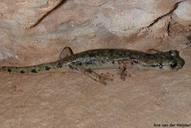|
Description
Total length to 127 mm for males (average 110 mm), up to 146 mm for
females (average 115 mm. Noellert and Noellert (1992) report the finding
of a 150 mm female. Tail oval in cross section
and slightly less than half the total length. Limbs well developed, hind legs
slightly longer than front legs. Front feet with 4, hind feet with 5 broad,
flattened digits. Coloration as in other Hydromantes species highly
variable, even within populations. Base color from dark brown to black, with
spotted, blotched or marbled pattern. Pattern may be in yellow, ochre,
gray-green or (rarely) flesh color. Some individuals have an entirely yellow
dorsum (the "flavus"-type). The ventral side is bright and sometimes
translucent, showing the abdominal organs and their contents. Although the
venter usually is plain, a slight brown or black spotting of the throat,
venter and tail also occurs. The extremities are usually in the same color
as the dorsum. Rarely they are colored brighter than the dorsum or in a
different color altogether (Boehme et al 1999).
Distribution and Habitat
Country distribution from AmphibiaWeb's database: Italy
H. flavus is a northeastern Sardinian endemic inhabiting the Monte Albo
chain and its hilly northern extension, between Siniscola and the Podosa river,
north of Siniscola
(Province of Nuoro). The species' altitudinal distribution ranges from 40m
(in the "Grotta di Cane Gortoe" cave) to 1040 m a.s.l. (cave "Conca 'e Crapa",
SW end of Monte Albo range)
(Gasc 1997). The preferred temperature of
H. flavus and other Sardinian Hydromantes species is slightly
higher than that of mainland species. H. flavus is very abundant,
like other Hydromantes species, in caves and under rocks
(Boehme et al 1999).
Life History, Abundance, Activity, and Special Behaviors
Life history information is very sparse. It is assumed that
the life history and habitat choice are similar to those of H. ambrosii.
Like other Hydromantes-species, H. flavus produces a deterring
secretion from dorsal skin glands. The bright coloration of some individuals
can therefore be considered aposomatic (Boehme et al 1999).
Trends and Threats
The forests of the Monte Albo have been subject to deforestation since the end
of the 19th century. This deforestation has changed the primary oak forests
(Querqus ilex) and Maquis into rocky fields with sparse vegetation.
These severe environmental changes have not affected the populations of
H. flavus to any great extent as yet. Populations of H. flavus have
been found to breed even in the most heavily affected areas, thanks to their
highly specialized biology. Moreover, Monte Albo is inaccessible and
practically uninhabited. Therefore, H. flavus should not be considered
an endangered species, even though it has a restricted range
(Boehme et al 1999).
References
Boehme, W., Grossenbacher, K., and Thiesmeier, B. (1999). Handbuch der Reptilien und Amphibien Europas, band 4/I:Schwanzlurche (Urodela). Aula-Verlag, Wiesbaden.
Gasc, J.-P. (1997). Atlas of Amphibians and Reptiles in Europe. Societas Europaea Herpetologica, Bonn, Germany.
Nöllert, A. and Nöllert, C. (1992). Die Amphibien Europas. Franckh-Kosmos Verlags-GmbH and Company, Stuttgart.
Stumpel-Rieks, S. E. (1992). Nomina Herpetofaunae Europaeae. AULA-Verlag, Wiesbaden.
Originally submitted by: Arie van der Meijden (first posted 1999-10-26)
Edited by: David B. Wake (2021-01-26)Species Account Citation: AmphibiaWeb 2021 Hydromantes flavus: Monte Albo Cave Salamander <https://amphibiaweb.org/species/4073> University of California, Berkeley, CA, USA. Accessed Nov 23, 2024.
Feedback or comments about this page.
Citation: AmphibiaWeb. 2024. <https://amphibiaweb.org> University of California, Berkeley, CA, USA. Accessed 23 Nov 2024.
AmphibiaWeb's policy on data use.
|




 Raffaëlli Account
Raffaëlli Account Map of Life
Map of Life